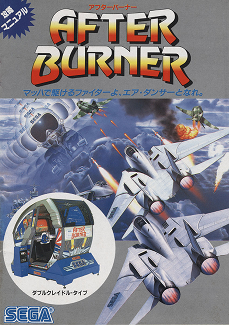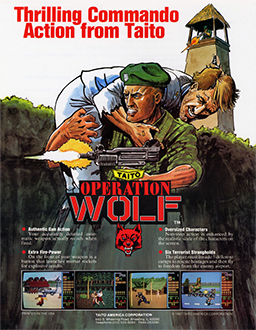
Darius II is a 1989 arcade shooter video game developed and published by Taito. It is a direct sequel to the 1987 title, Darius. It was later released as Sagaia in Japan in 1991 for the Game Boy as well as non-Japanese ports. A remake was released for the PC Engine Super CD-ROM² as Super Darius II in 1993.

Final Lap is a 1987 racing simulation video game developed and published by Namco. Atari Games published the game in the United States in 1988. It was the first game to run on Namco's then-new System 2 hardware and is a direct successor to Namco's Pole Position (1982) and Pole Position II (1983). It was ported to the Famicom by Arc System Works, making it Arc System Works' debut game.

After Burner is a rail shooter arcade video game developed and released by Sega in 1987. The player controls an American F-14 Tomcat fighter jet and must clear each of the game's eighteen unique stages by destroying incoming enemies. The plane is equipped with a machine gun and a limited supply of heat-seeking missiles. The game uses a third-person perspective, as in Sega's earlier Space Harrier (1985) and Out Run (1986). It runs on the Sega X Board arcade system which is capable of surface and sprite rotation. It is the fourth Sega game to use a hydraulic "taikan" motion simulator arcade cabinet, one that is more elaborate than their earlier "taikan" simulator games. The cabinet simulates an aircraft cockpit, with flight stick controls, a chair with seatbelt, and hydraulic motion technology that moves, tilts, rolls and rotates the cockpit in sync with the on-screen action.

Space Harrier is a third-person arcade rail shooter game developed by Sega and released in 1985. It was originally conceived as a realistic military-themed game played in the third-person perspective and featuring a player-controlled fighter jet, but technical and memory restrictions resulted in Sega developer Yu Suzuki redesigning it around a jet-propelled human character in a fantasy setting. The arcade game is controlled by an analog flight stick while the deluxe arcade cabinet is a cockpit-style linear actuator motion simulator cabinet that pitches and rolls during play, for which it is referred as a taikan (体感) or "body sensation" arcade game in Japan.

Super Sprint is a racing video game released by Atari Games and Midway Games in 1986. Up to three players drive Formula One-like cars on a circuit that is viewed from above. The game is a successor to Gran Trak 10 and the Sprint series, which were black-and-white games from the 1970s. A sequel, Championship Sprint, was released later in the same year.

Operation Wolf is a light gun shooter arcade game developed by Taito and released in 1987. It was ported to many home systems.

Operation Thunderbolt is a light gun shooter video game developed by Taito and released for arcades in 1988. As the sequel to Operation Wolf, changes include two-player gameplay with two positional gun controllers mounted on the arcade cabinet, and a new forward-scrolling pseudo-3D perspective combined with side-scrolling sections.

TX-1 is an arcade racing simulation game developed by Tatsumi and released in 1983. It was licensed to Namco, who in turn licensed it to Atari, Inc. for release in the United States, thus the game is considered a successor to Pole Position and Pole Position II. It was also released in the United Kingdom, Ireland and mainland Europe via Atari Ireland.

Hot Chase is an arcade game released in 1988 by Konami. In the game, players drive a white Porsche 959 out of an enemy country to the Border crossing of a friendly one. The car has a bomb attached to it that explodes in a set time. If the bomb explodes, players must restart. There are many obstacles along the way, including railroad crossings, military checkpoints, helicopters that shoot at the car and other cars. The gameplay is said to be similar to Chase H.Q..

Astron Belt (アストロンベルト) is a LaserDisc video game in the form of a third-person, space combat rail shooter, released in arcades in 1983 by Sega in Japan, and licensed to Bally Midway for release in North America. Developed in 1982, it was the first major arcade laserdisc video game. The game combines full-motion video (FMV) footage from the laserdisc with real-time 2D graphics. The arcade game was available in both upright and cockpit arcade cabinets, with the latter having illuminated buttons on the control panel, a larger 25" monitor, and a force feedback vibrating seat.

Pole Position II is the sequel to racing simulation game Pole Position, released by Namco for arcades in 1983. As with its predecessor, Namco licensed this game to Atari, Inc. for US manufacture and distribution. Atari Corporation released a port as the pack-in game for its Atari 7800 ProSystem console launch in 1986. Pole Position arcade machines can be converted to Pole Position II by swapping several chips.

Quartet (カルテット) is a run and gun video game released by Sega for arcades in 1986. Quartet allows one to four players to guide a set of characters through a base taken over by an army of robots. Players control either Joe (yellow), Mary (red), Lee (blue), or Edgar (green) across 32 side-scrolling levels. The object of the game is to advance through the level, fighting opponents that come out of portals in the walls, and eventually defeat a boss that carries the door key used to open the "exit door" for the level.

Cobra Command, known as Thunder Storm (サンダーストーム) in Japan, is an interactive movie shooter game originally released by Data East in 1984 as a LaserDisc-based arcade game. Released as an arcade conversion kit for Bega's Battle (1983), Cobra Command became one of the more successful laserdisc games in 1984. A Mega-CD port of Cobra Command developed by Wolf Team was released in 1992.

Enduro Racer (エンデューロレーサー) is an arcade racing game from Sega. It was released in 1986 with two arcade cabinet versions, a stand-up cabinet with handlebars and a full-sized dirt bike cabinet. It is often seen as a dirt racing version of Hang-On, as it uses a similar engine and PCB. The game was later released for the Master System in 1987, the ZX Spectrum and Commodore 64 in 1988, and the Amstrad CPC and Atari ST in 1989.

Monaco GP is an arcade racing game released by Sega in November 1979 in Japan, and January 1980 worldwide. An upgraded version, Pro Monaco GP, was released later in 1980. One of the last Sega games to use TTL chips instead of a microprocessor CPU, the game has players race against a clock and pass rival racers while attempting to earn points driving through five areas.

Galaxy Force is a rail shooter video game developed and released by Sega for arcades in 1988. The player assumes control of a starship named the TRY-Z, as it must prevent the Fourth Empire from taking over the entire galaxy. Gameplay involves shooting down enemies using either a laser shot or a limited supply of heat-seeking missiles, all while avoiding collision with projectiles or obstacles and making sure the ship's energy meter doesn't fully deplete. It ran on the Sega Y Board arcade system, and was released with a motion simulator cockpit arcade cabinet version like previous Sega Super Scaler games.

Star Wars: Return of the Jedi is an isometric scrolling shooter released as an arcade video game in 1984 based on the film from the previous year. It was the second arcade release by Atari based on the Star Wars franchise, but using raster graphics rather than the vector graphics of the first and third arcade games. Several home ports were released by Domark for the Amstrad CPC, BBC Micro, ZX Spectrum, Atari ST, Commodore 64, and Amiga in 1988. The game is included as an unlockable extra on Star Wars Rogue Squadron III: Rebel Strike for GameCube.

Thunder Blade is a third-person shoot 'em up video game released by Sega for arcades in 1987. Players control a helicopter to destroy enemy vehicles. The game was released as a standard stand-up arcade cabinet with force feedback, as the joystick vibrates. A helicopter shaped sit-down model was released, replacing the force feedback with a cockpit seat that moves in tandem with the joystick. It is a motion simulator cabinet, like the previous Sega Super Scaler games Space Harrier (1985) and After Burner (1987). The game's plot and setting was inspired by the film Blue Thunder (1983).

Under Fire is a light gun shooter released as an arcade game in 1994 by Taito. The game uses graphics created using digitized photographs and two player gameplay using gun controllers, similar to Konami's Lethal Enforcers. Unlike Lethal Enforcers, the controllers are not traditional light guns but rather operate using infrared technology. They also provide force feedback when the player pulls the trigger. The game was never released for home consoles.

Gun Buster, also known as Gunbuster (ガンバスター) and released in North America as Operation Gunbuster, is a first-person shooter video game developed by Taito and released for arcades in 1992. In contrast to on-rail light gun shooters at the time, this was one of the first arcade games to feature free-roaming FPS gameplay, the same year Wolfenstein 3D was released on personal computers.





















